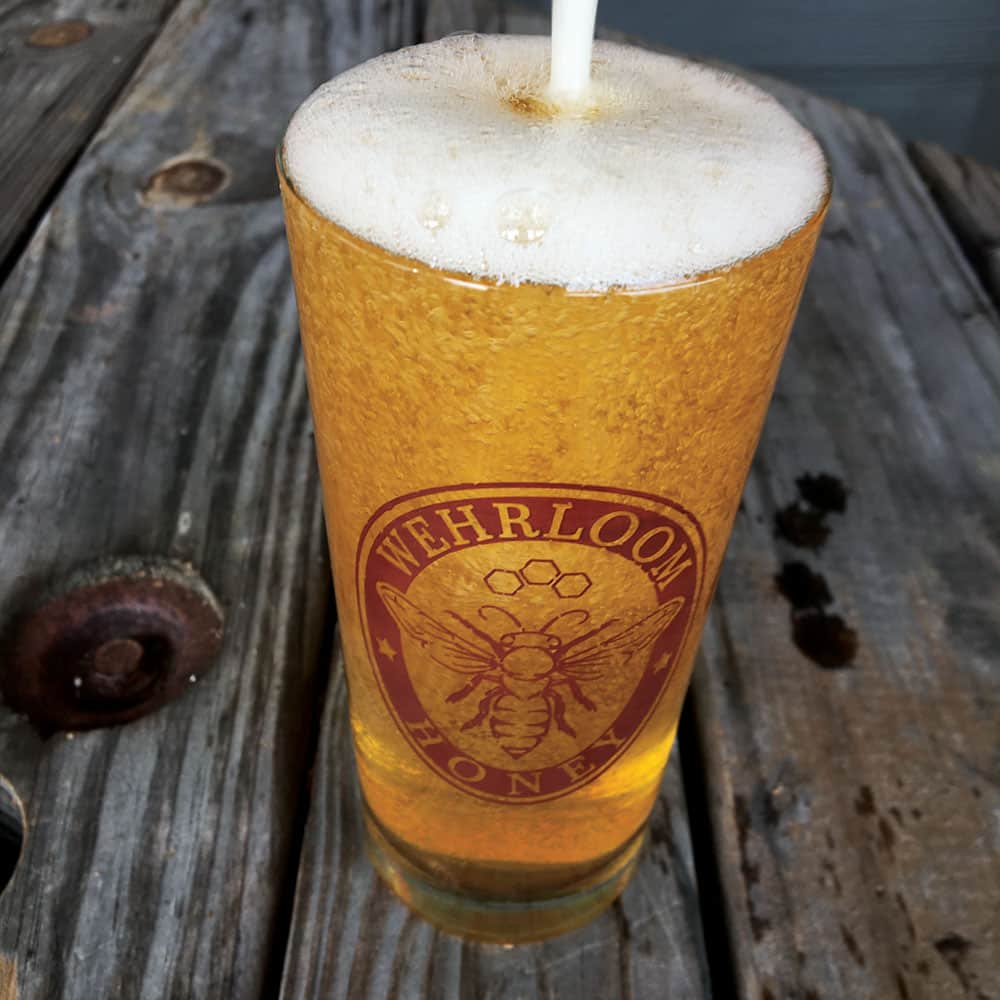Easy to brew, this versatile drink made from fermented honey is gaining popularity in the Southern craft scene.
Becky Starr and her husband Ben first tasted mead, an alcoholic beverage made by fermenting honey and water, at a renaissance fair. Soon after their first taste, she and Ben started making mead for fun.
The Starrs shared their homemade mead with friends, who gave it rave reviews. Though the Starrs believed their friends were just happy to be getting free booze, they decided to enter a competition. To their utter surprise, they won Best in Show at the International Mead Association’s Mead Festival. Two months after that win, Becky was laid off, which she says “felt like divine intervention.” They started scouting locations and opened Starrlight Mead in Pittsboro, N.C., a few years later.
Mead can mimic a variety of drinks; Starrlight’s brews are more wine-style, but mead can resemble wine, beer, cider, or even kombucha, depending on the fermentation and flavoring. “People expect meads to be sweet, thick, and syrupy, and it’s not true,” said Becky. “It’s a balance between science and art, getting the fermentation right as well as adding spices, herbs, fruits, and other elements to enhance the flavor and create the preferred style.”
Ben, who Becky describes as having “mad scientist tendencies,” is the brewmaster. When he gets bored, he creates new flavors, including Kickin’ Cranberry Orange Mead, a fall brew with chipotle peppers inspired by a Guy Fieri recipe he saw on the Food Network.
Aron Wehr of Wehrloom Honey in Robbinsville, N.C., started “playing around” with mead in part to expand on the success of their business selling honey and honey-derived products. Initially it did not go well. “We made a lot of terrible mead,” said Wehr, who pitied friends who volunteered to taste test. “You could see in their faces that it was horrible.” Wehr says he donated most of that mead “to the toilet” and kept experimenting.
Eventually, he got it right—Wehlroom now has two meaderies, one in Asheville and one in Robbinsville. “I don’t like drinks that are crazy sweet,” says Wehr, who has Celiac’s disease and can’t drink beer (mead is gluten-free). The menu at Wehrloom’s Asheville Meadery includes a variety of meads, including beer-like offerings like Yardsale, which contains hops and “has all the qualities of a juicy IPA,” and BeeWizer, which is more “lightly hopped for the perfect blend of bitter and sweet.”
For Wehr, who has an MFA in painting and has taught drawing, painting, and printmaking at the college level, mead is about creativity. “It’s about everything from experimenting with flavors to figuring out how to fix broken equipment.” Their brew Twice Im“peach”ed came about after Wehr added a half-batch of blackberry mead to a peach brew that had come out too sweet due to underfermentation. Now it’s on the menu at their Asheville Meadery as a Limited Edition offering to get “before it’s locked up.”
In addition to using fruit and herbs to flavor meads, the honey plays a big role. Honey and its flavors vary wildly, based on a number of factors including the season, what plants are nearby and in bloom, how far the bees travel, and if they pollinate a range of plant types or are limited to just one. Wildflower honey is named as such because the bees have been allowed to roam and gather nectar from a wide variety of plants, while varietal honey comes from bees harvesting from primarily one plant type. One of Starrlight’s suppliers takes his bees to the mountains to pollinate on blooming sourwood trees; the resulting honey has a buttery flavor with caramel notes.
Most of Starrlight’s honey supply comes from North Carolina beekeepers; they’ve purchased 5.67 tons of honey in the last 12 months and 37.2 tons since they opened 11 years ago. A map in the tasting room shows the locations of all the beekeepers they’ve bought from. Their purchase size depends on the beekeepers; for a small operation with only a few hives, Starrlight might purchase five gallons. A bigger operation with 100 hives might yield 25 gallons.

Wehrloom Honey began when Aron bought his wife two beehives and beekeeping equipment as a Christmas present. What began as a hobby grew into a large-scale operation that now supports a wide variety of products, including soap, lotion, lip balm, candles, and other honey-derived products that also proved popular. “We don’t sell anything we don’t love,” said Wehr.
Wehrloom offers a monthly class at the Asheville meadery where participants can try making a small batch of mead. Wehr encourages people to be open to experimenting; “If it’s good, it’s good, and if it’s crap, it’s not a big deal—it’s only five gallons.”
Alison Schaefer, who brews mead at her home in Chapel Hill, N.C., is definitely open to experimentation. “I like to throw the things in the jar and see what happens,” she said. Schafer first tasted mead at Starrlight, where she got a brief tour of the equipment and a recipe for mead whose ingredients were dead simple: honey, water, yeast, oranges, cinnamon sticks, cloves, and raisins. She used a well-cleaned gallon glass jar from Target as a container and got going, turning three pounds of honey into a gallon of mead, or roughly four bottles.
“It’s the easiest of alcoholic beverages to brew,” said Schaefer, who had brewed beer but was drawn to the simplicity of mead. “You can make it in smaller batches than beer and you don’t have to worry as much. It becomes alcoholic so quickly there’s not much risk of infection.”
The fermentation happens in a matter of days, but Schaefer lets her batches age for several months to let the flavor mellow out. She’s made mead using different types of honey, including buckwheat honey from Pennsylvania that imparted an earthy, vegetal flavor and was less sweet than mead made with clover honey or tupelo honey, which has a high fructose content.
“It’s fun to have a hobby that you get to consume.” Schaefer says her mead, which tastes more like wine, is delicious.
The popularity of mead is expanding; in 2008, there were 60 meaderies in the country, and today there are over 500. With all the growth in the industry, Wehr points out that “nobody has stepped up in the mead world to be the New Belgium or Sierra Nevada. Maybe that’ll be us. It’s gotta be somebody.”








